Flemish Harpsichord
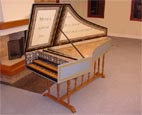
Compass: AA - d'''
![]()
![]()
![]()
![]()
Flemish Harpsichord 
Compass: AA - d'''
Size: 2235mmL x 814mmW X 265mmH
Disposition:
Upper manual
¨8'
¨8' (Nazard Lute)
Lower manual
©8' (Peau de buffle)
©8'
©4'
@
Reference:
1. Drawings and photographs by Friends of St. Cecilia's Hall, University of Edinburgh.
2. The Russell Collection of Early Keyboard Instruments, Edinburgh University Press.
Model: Joannes Ruckers, 1638
The original instrument made by J. Ruckers has a single 8'register and
the upper manual was so called a transposed keyboard. Presently
it is kept in the Russell Collection of the University of Edinburgh.
Making an exact replica was not the original purpose but effort was focused
to reproduce its tone character. The upper manual was made as a parallel,
not the transposed, keyboard.
Since building an exact replica was abandoned, further deviations, including
double 8' register with a full chromatic, instead of short octave, keyboard,
Peau de buffle and Nazard Lute, were made. Because of these additional
features, historically it does not possibly exist in both geography and
periodization points of view.




![]()
![]()
![]()
![]()
French Harpsichord 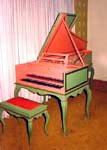
CompassF FF - f'''
SizeF 2317mmL x 931mmW x 279mmH
Disposition:
Upper manual
¨8'
Lower manual
©8'
©4'
ReferenceF
1. Drawings and measurement notes by Grant O'Brien, published from
The Friends of St. Cecilia's Hall and The Russell Collection of Harpsichords.
2. Photographs by The Friends of St. Cecilia's Hall and The Russell Collection
of Harpsichords.
3. The Russell Collection of Early Keyboard Instruments, Edinburgh University Press.
4. 18th Century French Harpsichord by Frank Hubbard, as an instruction
manual for a kit.
ModelF Pascal Taskin, 1769
This instrument has been in The Russell Collection in Edinburgh, since
it was brought there in 1952. It had been restored in 1882 by Louis
Tomasini, whose inscription is seen on the restplank. After this
restoration, Erards borrowed it and copied. This is assumed to be
the start of modern harpsichord making.
CompassFFF - d''' 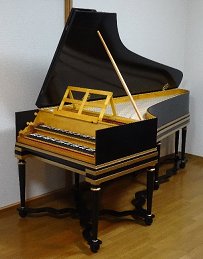
SizeF2345mmL x 906mmW X 280mmH
DispositionF
©8'
©4'
8'¨
ReferenceF
Drawings by Rase, 1983
Essay "meek mietkes" by Tilman Skowroneck http://skowroneck.wordpress.com/2010/01/27/meek-mietkes/
ModelFMichael Mietke 1700
Presently, the original instrument is in Schloss Charlottenburg, Berlin.
CompassFGG/HH|e3
SizeF1982oL x 829mmW x 237mmH
RegisterF
©8'
8'¨
ReferenceF
Drawing by Friedemann Hellwig 1977
ModelFChristian Vater 1738
Germanisches Nationalmuseum Nuremberg

CompassFGG - d''' 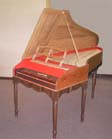
SizeF2233mmL x 814mmW X 218mmH
DispositionF
©8'
©4'
©8'
ReferenceF
1. Drawings and photographs produced by the Staatliches Institute for Musikforschung
Preussischer Kulturbeisitz
2. j
; a catalogue for collection of harpsichords and
virginals at the Staatliches Institute for Musikforschung Preussischer
Kulturbeisitz: edited by John Henry van der Meer, Martin Elste, Gunther
Wagner and written by: Harst Rase, Dagnar Draysen-Reber.
Special thanks to Ms Sabine Hoffmann, the restorer and Mr. Bernd Wittenbrink,
the librarian of the Staatliches Institute for Musikforschung Preussischer
Kulturbeisitz for their kind support of providing an opportunity to closely
study the original instrument and copies of literatures and records of
researches on the original instrument.
ModelFJohann Christoph Fleischer, 1710
 The original instrument is now in the Staatliches Institute for Musikforschung
Preussischer Kulturbeisitz in a playable condition. Besides this harpsichord,
5 clavichords by Johann Christoph Fleischer are preserved. However, this
is the only one extant harpsichord made by J. C. Fleischer.
The original instrument is now in the Staatliches Institute for Musikforschung
Preussischer Kulturbeisitz in a playable condition. Besides this harpsichord,
5 clavichords by Johann Christoph Fleischer are preserved. However, this
is the only one extant harpsichord made by J. C. Fleischer.
Pine is used in a whole structure. The soundboard has a cut-off bar and
ribs are placed between the cut-off bar and spine, parallel to te belly
rail. In the 1971 restoration, other ribs are added below the 8' bridge,
like ones often seen in German harpsichords. Respecting the restration,
this replica also employs these ribs. 4' hitchpin rail is about 4 Cm thick.
Now, the original instrument has a 2 Cm thick reinforcement member on top
of this thick hitchpin rail. However, this replica has no such reinforcement.
The registers are 8', 8' and 4' from the front to the back. As mentioned
above, there is only one set of 8' strings. The two 8' registers are to
provide a contrast in tone color with two different plucking points. It
is not like a slanting jack rail often seen in German harpsichords, typically
by Hans Muller as a riverhead. Difference in distance of the two plucking
points is about 2 centimeters in a whole compass. It is, however, enough
to produce clearly different tone characters. It seems to be an intended
effect to use the both registers at a time to make tones containing less
harmonics somewhat like virginals. Another feature needs to be mentioned
is there is no damper on the 4' jacks.
The highest note is expanded to d''' from the original compass of GG to
c'''

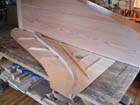
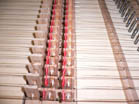
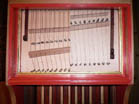
Italian Harpsichord 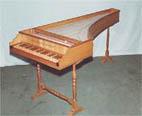
Compass: C/E - c'''
Size: 1906mmL x 720mmW x 173mmH
Disposition: 8' x 2
Reference:
1. Drawings and instructions by Denzil Wraight
2. Italian Harpsichord Building in the 16th and 17th Centuries by John D.Shortridge
Model: Giacomo Ridolfi, 1665
Original instrument made by Ridolfi is preserved at the Smithsonian Institution, Washington DC. A number of other
instruments, having similar features and structures, were also made in the same period in Italy and
this model can be assumed as one of the typical style of this kind.
Brass strings are used in the whole range and the tension of the strings is generally lower that that of ones made in other
countries in Europe. Material of the spine, bent side is about 4mm thick cypress. Due to this thin and lightly structured
body, the weight of the instrument is much lighter than those of Flemish and French, which are commonly used in
concerts.
This light weighted structure contributes to produce crisp and fast decaying tone characteristics. Usually, this type of
instrument is used in a heavily embellished outer case. However, as the entire body, as well as the sound board, vibrates
and helps to produce sound, no such outer case was made and it is just put on a simple stand.